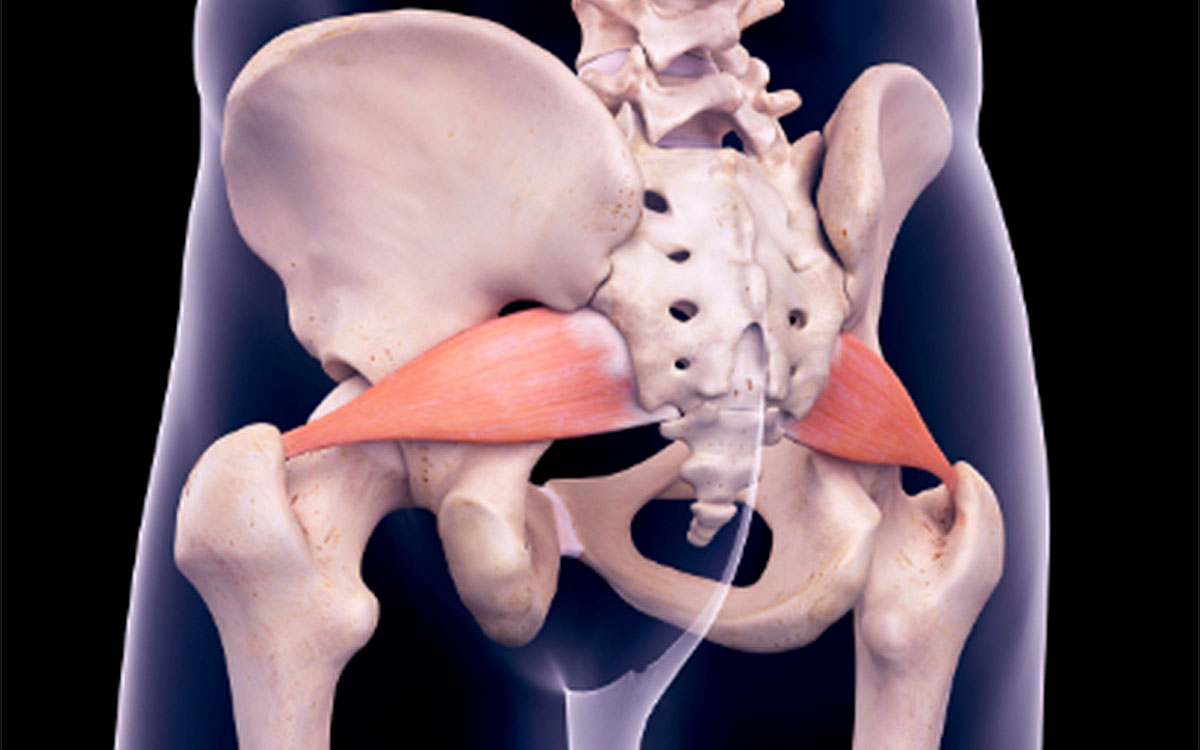
You may not know it from its name, but you definitely know it from the movements it facilitates. It’s a small muscle that’s attached to the sacrum, close to the base of the spine. It runs behind your gluteus muscles and attaches to your femur (leg bone) head.
If this muscle gets injured, overused, or stretched too much, it can get tight and chronically hurt. The piriformis muscle is right next to the sciatic nerve, and the pain from that area is often the piriformis compressing the sciatic nerve.2 This nerve starts in the lower spine and goes down the back of the leg, ending in the foot.
This is why sciatic pain from piriformis compression can show up in the back and lower buttocks, or all down the leg. Since the muscle helps with both sitting, standing, and walking, you can have piriformis pain both in motion and at rest.
Do you experience any of these common ways piriformis muscle pain shows up?
Pain / Spasms in the Buttocks
When the sciatic nerve gets pinched, it can cause or lead to a number of different sensations.
- You have buttock muscle pain when sitting.
- There’s a burning sensation in the buttocks.
- There are “pins and needles” in the buttocks, a feeling it’s “fallen asleep” or buzzing.
- You get a spasm in your buttock on one side.
Pain Above and Below Your Glutes
The sciatica is a long nerve. That’s why it’s not uncommon to get pain above and below your piriformis muscle. Here are common pain presentations.
- You get pain in the back of the upper thigh.
- You feel lower back pain or tingling, just above your glutes.
- You have sharp pain above your buttocks on both sides.
- You get pain in both your glute and groin area.
- You have muscle pain only on one side.
Pain with Certain Activities
Several specific activities increase the pressure on the muscle. This in turn compresses the sciatic nerve.
- You have pain climbing stairs.
- You have pain when you do something.
- You find you can’t sit for long periods of time.
- It hurts when you run or bike.
What Can Make Piriformis Pain Flare Up?
Frequent Running and Cycling
Exercise is good for muscles but frequent repetitive motion puts a strain on the small muscles. This pain may show up under the buttock when you’re running or biking.3 It can also show up as tightness later in the day.
Injury
Movements that raise your legs or hips can involve your piriformis. One common piriformis injury comes from lifting something heavy, especially from a squatting position. You can also injure it if you climb many stairs or hike up a steep incline. This motion of stepping up particularly increases pressure on the muscle and nerve.
Your piriformis can suffer injury if it’s engaged, then hit or stretched directly. This is frequently seen in car accidents, a twisted hip from a fall, or a direct hit during a sport.3
Desk and Seated Jobs
Seated jobs keep your piriformis compressed for long periods of time. It’s worse when you sit in a flexed position (letting your spine curve like a C).4 If you’ve noticed pain in your right buttock, or the pain is worse on the one side, check your pockets. If you keep a phone or wallet in a pocket, you can be adding to the pressure.
If you have a job that requires lots of driving, you’re also at risk for sciatic pain. This seated position while engaging your right foot can add to the pain in your right buttock.
Wheelchair Confinement
If you spend most of your waking hours in a wheelchair, then you’re in a sitting position most of the time.5 It’s often hard to maintain good posture while sitting throughout the entire day. Also, if you’re confined to a wheelchair, you may already struggle with muscle weakness. The problem is compounded if you also sleep in a recliner. At that point, you’ll be spending almost 24/7 in a seated position.
Prior hip surgery
Uneven or Misaligned Bones
Your piriformis is a key player in your leg/hip movement. If something makes your hips uneven, you’ll likely feel it in your piriformis muscle. Uneven leg length and spine discrepancies, like scoliosis, can significantly pinch that nerve and cause pain.7
What Piriformis Muscle Pain Treatments are Available?
It’s important to remember that different situations and levels of pain will likely have different treatment approaches. Piriformis irritation, piriformis syndrome, and sciatica can overlap, but they aren’t the same.
The gold standard for non-emergent sciatic pain is piriformis muscle stretches. You can do them at home or at work. Several easy piriformis exercises include:
Your doctor may also consider pain medication or muscle relaxers.
If you have chronic pain or pain from circumstances out of your control, you may find relief through surgery. Many people who use wheelchairs have had an accident or pain altering their quality of life experience relief from a piriformis release surgery or a piriformis removal.
Dr. Tollestrp pioneered the surgery to remove the piriformis muscle and has changed the lives of patients from all over the world who have come to see him for this surgery. If you or your doctor is considering a piriformis surgery, please give us a call at 702-666-0463. If you’re ready to start the intake process, you can fill out our New Patient Form here.
References:
- https://www.ncbi.nlm.nih.gov/books/NBK519497/#:~:text=The%20piriformis%20muscle%20is%20an,during%20flexion%20of%20the%20hip.
- https://www.webmd.com/pain-management/guide/piriformis-syndrome-causes-symptoms-treatments#1
- https://www.healthline.com/health/piriformis-syndrome#causes
- https://www.coachsofiafitness.com/how-to-sit-to-reduce-lower-back-and-neck-pain/
- https://journals.sagepub.com/doi/pdf/10.1177/136140969300700204
- https://pubmed.ncbi.nlm.nih.gov/9521528/
- https://www.health.harvard.edu/back-pain/ask-dr-rob-about-piriformis-syndrome
[This article is not meant to replace medical advice or diagnosis. Exercise videos linked in the article are not owned by Dr. Tollestrup.]
